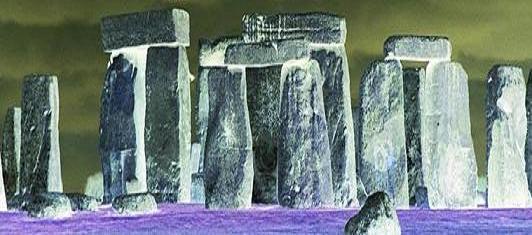BY LETTER
Archaeology
Image from Steve Bowers | |
| 72 Aurigae VII-B where the Saro-Mbuna - Roduimo Affair took place | |
Archaeology is the scientific study of historic or prehistoric sophonts and their cultures through recovery, documentation and analysis of material remains and environmental data: their architecture and artifacts, their reshaping of on the local landscape, their trash heaps and the waste products of industrial processes, the bodily remains of the people themselves and any domestic or commensal organisms, and so on. Analysis of written or other records, once they have been decoded, is generally regarded as the realm of historians, though of course the two fields support one another in many cases. Archaeology is particularly important where no such records exist, or where they are poorly understood, as is often the case with the remains of xenosophont civilizations.
There are a number of specialized fields of archaeology, of which the following are only a few:
Xenoarchaeology: (sometimes archaeoxenology) specifically the study of ancient alien (non-terragen) sapients and their cultures.
Archaeoartilectology: specifically the study of historical transingularity ai, especially of the Technocalypse, First Federation, and Inner Sphere eras, through analysis of their artifacts, communications, and remains
Archaeocomputology: the study of ancient layers of code and software buried deep in the operating systems and relays of the Known Net, especially through retro-engineering, retrocoding, and simulation runs.
 Image from Steve Bowers |
See Also
Timeline of the Preterragen eraArticles
- Archaeologists - Text by M. Alan Kazlev, modified from the original write-up by Robert J. Hall
The Archaeologist attempts to reconstruction sophont history and culture from the analysis of physical remains left behind by previous cultures. - Archaeology - Text by M. Alan Kazlev
The scientific study of historic or prehistoric peoples or sapients and their cultures by analysis of their artefacts, inscriptions, monuments, and other such remains, including bones, tools, artefacts, plant remains, especially those that have been excavated. Hence archaeologist - Archeocliology - Text by M. Alan Kazlev
Understanding the past through cliological methods. An important element in archaeological research. However, the results can be misleading, even gigoical, when there are insufficient physical data. For this reason, and contrary to the statements of its most enthusiastic advocates, archeocliology may supplement, but can never replace, careful fieldwork. - Batholithic Civilisation, The - Text by Steve Bowers
Unnamed species: HIE201NPE - Classical Age - Text by M. Alan Kazlev
In some usages, a generic term for Old Earth's early to middle Agricultural Age (bronze age and iron age) civilizations. Also used at times for civilizations on Old Earth or in Solsys prior to the Technocalypse. Sometimes this term is used to refer to a civilization's local antecedents, especially in cases where technologies or social complexity have advanced over time. - Eden Institute of Xenoscience - Text by M. Alan Kazlev
A successful, respected, highly formalized and highly conservative Institute and academocracy, located at Niu Mynti. The Institute specializes in xenobiology, xenology, xenopsychology, xenodiplomacy and xenolinguistics, although it also covers many related disciplines. It collects information from all known alien biospheres and cultures, sending out expeditions to study new alien species and acting as consultants on all forms of Terragen-alien interactions. - Fargate, The - Text by Todd Drashner
Wormhole of presumably alien manufacture discovered in the Metasoft volume in 10233. Travel through the gate transports one to a location in intergalactic space. The exact location in relation to the Milky Way galaxy is unknown since instruments sent through the portal have been unable to pinpoint any familiar configurations of galaxies. It is hypothesized that the Fargate may exit beyond the current universal Event Horizon or even into another universe. There is of course no evidence for this and most serious researchers are confident that the coordinates for The Other Side, as it is called, will be pinpointed eventually. - Hamilton Institute of Exopaleontology, The - Text by Aaron Hamilton, M. Alan Kazlev, John M. Dollan
One of the great scientific Houses of the Second Federation period, the Institute was founded on the new University planet of Delta Upali C/D II during the golden age of the 6th millennium, when relativistic exploration ships were increasingly encountering ancient and enigmatic ruins and relict tech of lost civilizations. - Holocene Epoch - Text by M. Alan Kazlev and Stephen Inniss
On Old Earth the Holocene ("entirely recent") is the most recent but one epoch in geologic time, lasting from about 12,000 BT (10,000 b.c.e.) to the Great Expulsion. This brief span of time from the birth of agriculture until the end of human baseline dominance on the species' home planet was the Golden Age according to most Anthropist sects. It was preceded by the Pleistocene and succeeded by the Gaiacene. - Inhibitor - Text by M. Alan Kazlev
Hypothetic super-powerful alien race or races proposed to explain why most advanced civilizations fail after only a few tens of thousands to a few millions of years. The Dawn Hunters are the most popular example of inhibitors, although it is not known if they even exist, or if they do, if they really are inhibitors. - Ozymandias Institute, The - Text by Stephen Inniss
A wealthy and widespread organization that studies the eventual fates of all structures, Terragen and otherwise. - Paleolithic - Text by M. Alan Kazlev
The old stone age. Among Old Earth hominids the stage of development of the most primitive stone tools. Also applied to analogous stages among xenosophont tool users. - Saro-Mbuna - Roduimo Affair - Text by Aaron Hamilton
An incident on the Type-L moon 72 Aurigae VII-B during the period of bitter rivalry between the Hamilton Institute of Exopalaeontlogy and the Eden Institute of Xenoscience.
Related Topics
Development Notes
Text by M. Alan Kazlev
modified by Stephen Inniss
Initially published on 04 October 2001.
modified by Stephen Inniss
Initially published on 04 October 2001.
Additional Information






